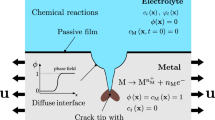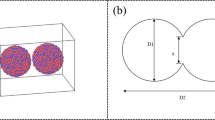Abstract
Considering the chemical reaction during metal oxidation at high temperature, a coupled diffusion–reaction–mechanics model of the metallic oxidation is developed, which is different from the existing mechanochemistry coupling model. Seen from the coupled model, the hydrostatic pressure depending on the diffusion and reaction is a harmonic function if the body force is ignored. Analytical solutions of the concentration and hydrostatic pressure in the steady state are obtained. Then a numerical example in the unsteady state is performed by means of the finite difference method. Numerical results show that the distribution of the concentration in the thin plate is nonlinear due to the interactions among diffusion, reaction and stress.
Similar content being viewed by others
References
Saillard A., Cherkaoui M., Capolungo L., Busso E.P.: Stress influence on high temperature oxide scale growth: modeling and investigation on a thermal barrier coating system. Philos. Mag. 90, 2651 (2010)
Entchev P.B., Lagoudas D.C., Slattery J.C.: Effects of non-planar geometries and volumetric expansion in the modeling of oxidation in titanium. Int. J. Eng. Sci. 39, 695 (2001)
Garikipati K., Rao V.S.: Recent advances in models for thermal oxidation of silicon. J. Comput. Phys. 174, 138 (2001)
Golmon S., Maute K., Dunn M.L.: Numerical modeling of electrochemical–mechanical interactions in lithium polymer batteries. Comput. Struct. 87, 1567 (2009)
Cui Y., Wei Q.Q., Park H.K., Lieber C.M.: Nanowire nanosensors for highly sensitive and selective detection of biological and chemical species. Science 293, 1289 (2001)
Walter E.C., Penner R.M., Liu H., Ng K.H., Zach M.P., Favier F.: Sensors from electrodeposited metal nanowires. Surf. Interface Anal. 34, 409–412 (2002)
Bakkers E.P.A.M., Borgström M.T., Verheijen M.A.: Epitaxial growth of III-V nanowires on group IV substrates. MRS bull. 32, 117 (2007)
Zhu G.N., Wang Y.G., Xia Y.Y.: Ti-based compounds as anode materials for Li-ion batteries. Energy Environ. Sci. 5, 6652 (2012)
Zhang J.Z.: Metal oxide nanomaterials for solar hydrogen generation from photoelectrochemical water splitting. MRS bull. 36, 48 (2011)
Ling Y.C., Wang G.M., Reddy J., Wang C.C., Zhang J.Z., Li Y.: The influence of oxygen content on the thermal activation of hematite nanowires. Angew. Chem. 124, 4150 (2012)
Saillard A., Cherkaoui M., El Kadiri H.: Stress-induced roughness development during oxide scale growth on a metallic alloy for SOFC interconnects. Model. Simul. Mater. Sci. Eng. 19, 015009 (2011)
Freund L.B., Nix W.D.: A critical thickness condition for a strained compliant substrate/epitaxial film system. Appl. Phys. Lett. 69, 173 (1996)
Zhang T.Y., Lee S., Guido L.J., Hsueh C.H.: Criteria for formation of interface dislocations in a finite thickness epilayer deposited on a substrate. J. Appl. Phys. 85, 7579 (1999)
Panicaud B., Grosseau-Poussard J., Dinhut J.: General approach on the growth strain versus viscoplastic relaxation during oxidation of metals. Comput. Mater. Sci. 42, 286 (2008)
Maharjan S., Zhang X., Wang Z.: Effect of oxide growth strain in residual stresses for the deflection test of single surface oxidation of alloys. Oxidation Metals 77, 93 (2012)
Clarke D.R.: The lateral growth strain accompanying the formation of a thermally grown oxide. Acta Mater. 51, 1393 (2003)
Hu S.M.: Stress-related problems in silicon technology. J. Appl. Phys. 70, R53 (1991)
Evans A.G., Hutchinson J.W.: The thermomechanical integrity of thin films and multilayers. Acta Metall. Mater. 43, 2507 (1995)
Hsueh C.H., Evans A.G.: Residual stresses and cracking in metal/ceramic systems for microelectronics packaging. J. Am. Ceram. Soc. 68, 120 (1985)
Volkert C.A.: Stress and plastic flow in silicon during amorphization by ion bombardment. J. Appl. Phys. 70, 3521 (1991)
Volkert C.A.: Density changes and viscous flow during structural relaxation of amorphous silicon. J. Appl. Phys. 74, 7107 (1993)
Evans H.E.: Stress effects in high temperature oxidation of metals. Int. Mater. Rev. 40, 1 (1995)
Bull S.J.: Modeling of residual stress in oxide scales. Oxid. Metals. 49, 1 (1998)
Wang D., Wu X., Wang Z., Chen L.: Cracking causing cyclic instability of LiFePO4 cathode material. J. Power Sources. 140, 125 (2005)
Krishnamurthy R., Srolovitz D.J.: Stress distributions in growing oxide films. Acta Mater. 51, 2171 (2003)
Stephen L.C.: Mechanochemistry: A tour of force. Nature. 487, 176 (2012)
Hickenboth C.R., Moore J.: Biasing reaction pathways with mechanical force. Nature. 446, 423 (2007)
Hu S.L., Shen S.P.: Non-equilibrium thermodynamics and variational principles for fully coupled thermal–mechanical–chemical processes. Acta Mech. 224, 2895 (2013)
Suo Y.H., Shen S.P.: General approach on chemistry and stress coupling effects during oxidation. J. Appl. Phys. 114, 4905 (2013)
Sallès-Desvignes I., Bertrand G., Montesin T., Favergeon J.: Coupling between diffusion, stress field and chemical reaction in a metal– gas oxidation. Solid State Phenom. 72, 9 (2000)
Prussin S.: Generation and distribution of dislocations by solute diffusion. J. Appl. Phys. 32, 1876 (1961)
Li J.C.M.: Physical chemistry of some microstructural phenomena. Metall. Trans. A. 9, 1353 (1978)
Lee S.B., Wang W.L., Chen J.R.: Diffusion-induced stresses in a hollow cylinder: constant surface stresses. Mater. Chem. Phys. 64, 123 (2000)
Wang W.L., Lee S.B., Chen J.R.: Effect of chemical stress on diffusion in a hollow cylinder. J. Appl. Phys. 91, 9584 (2002)
Larche F.C., Cahn J.W.: The interactions of composition and stress in crystalline solids. J. Res. Natl. Bur. Stand. 89, 467 (1984)
Yang F.Q.: Interaction between diffusion and chemical stresses. Mater. Sci. Eng. A. 409, 153 (2005)
Rhines F.N., Wolf J.S.: The role of oxide microstructure and growth stresses in the high-temperature scaling of nickel. Metall. Trans. 1, 1701 (1970)
Yang F.Q.: Effect of local solid reaction on diffusion-induced stress. J. Appl. Phys. 107, 103516 (2010)
Landau L.D., Lifschitz E.M.: Theory of Elasticity, 3rd ed. Oxford, England (1986)
Timoshenko S.P., Goodier J.N.: Theory of elasticity. McGraw-Hill, New York (1970)
Morales-Rodriguez, R.: Thermodynamics Fundamentals and its Application in Science. InTech, Rijeka (2012)
Li J.C.M.: Chemical potential for diffusion in a stressed solid. Scr. Metall. 15, 21 (1981)
Zhang X., Shyy W., Sastry A.M.: Numerical simulation of intercalation-induced stress in Li-ion battery electrode particles. J. Electrochem. Soc. 154, A910 (2007)
Bhandakkar T.K., Gao H.: Cohesive modeling of crack nucleation under diffusion induced stresses in a thin strip: implications on the critical size for flaw tolerant battery electrodes. Int. J. Solids Struct. 47, 1424 (2010)
Devereux O.F.: Topics in metallurgical thermodynamics. Wiley, (1983)
De Groot S.R., Mazur P.: Non-equilibrium thermodynamics. Courier Dover, New York (1984)
Simon A.M.: A criticism of the postulated quadratic steady-state concentration profile for strain gradient induced hydrogen diffusion in metallic membranes. Int. J. Hydro. Energy. 22, 27 (1997)
Author information
Authors and Affiliations
Corresponding author
Rights and permissions
About this article
Cite this article
Suo, Y., Shen, S. Coupling diffusion–reaction–mechanics model for oxidation. Acta Mech 226, 3375–3386 (2015). https://doi.org/10.1007/s00707-015-1366-7
Received:
Revised:
Published:
Issue Date:
DOI: https://doi.org/10.1007/s00707-015-1366-7




